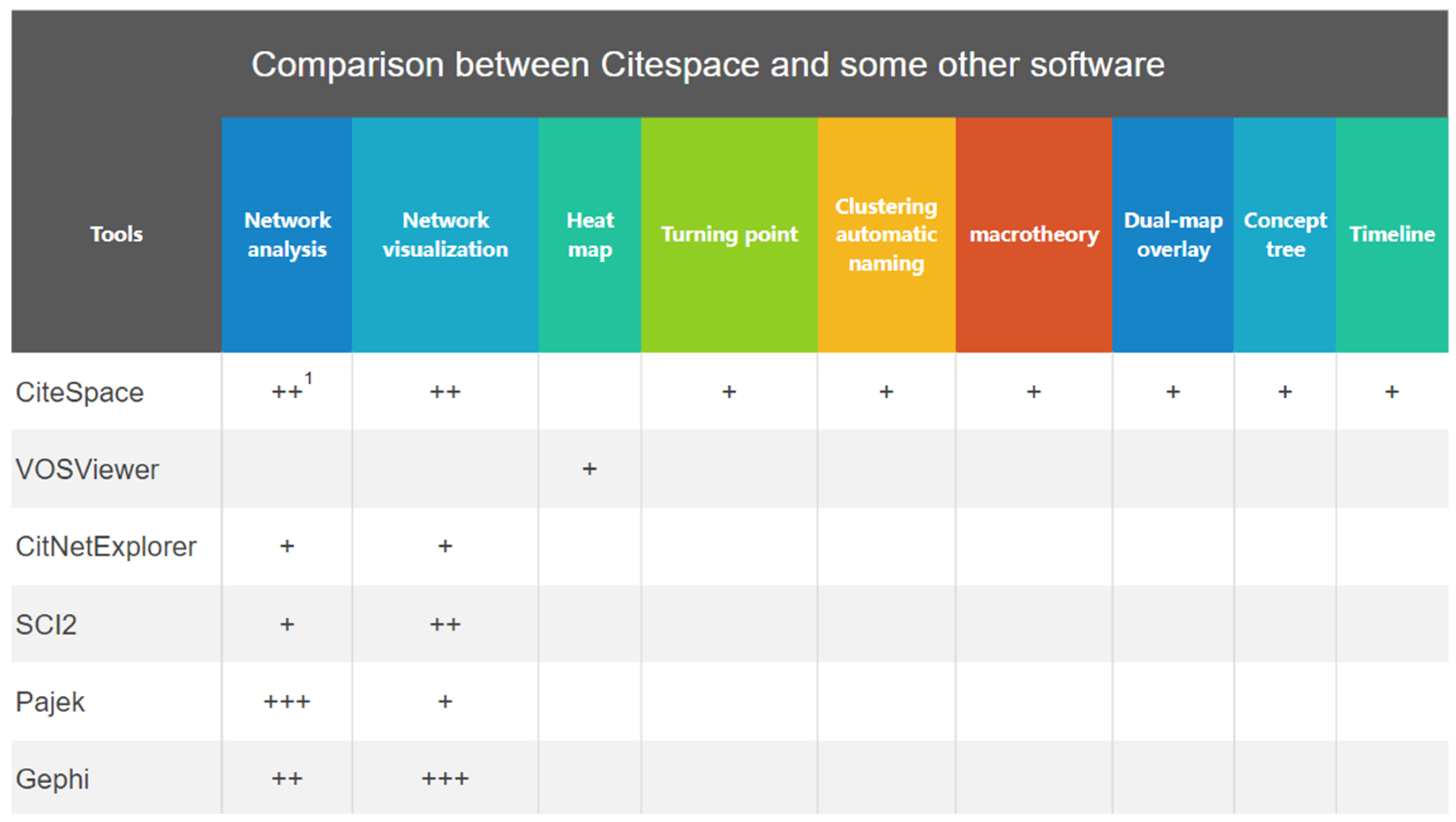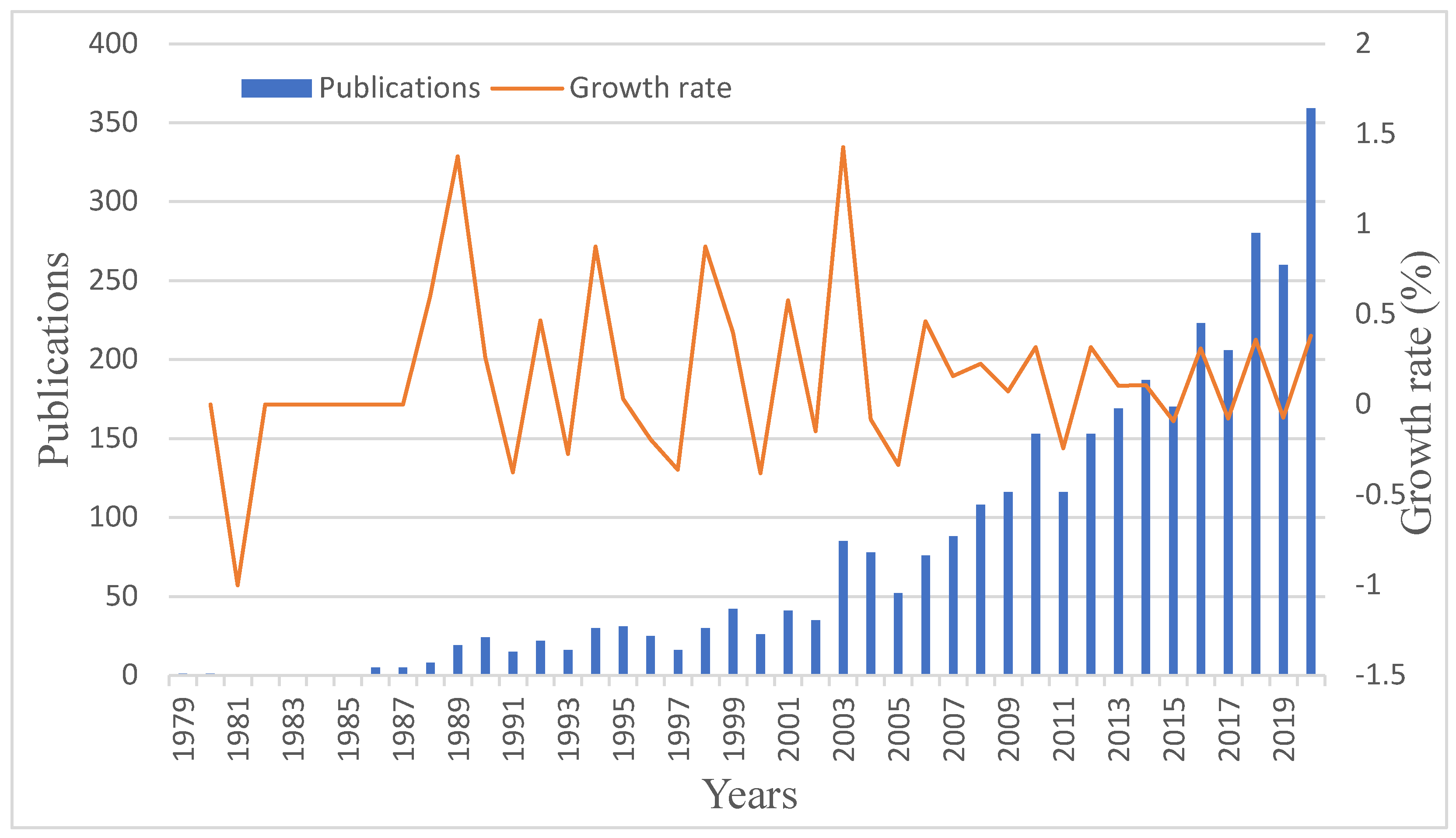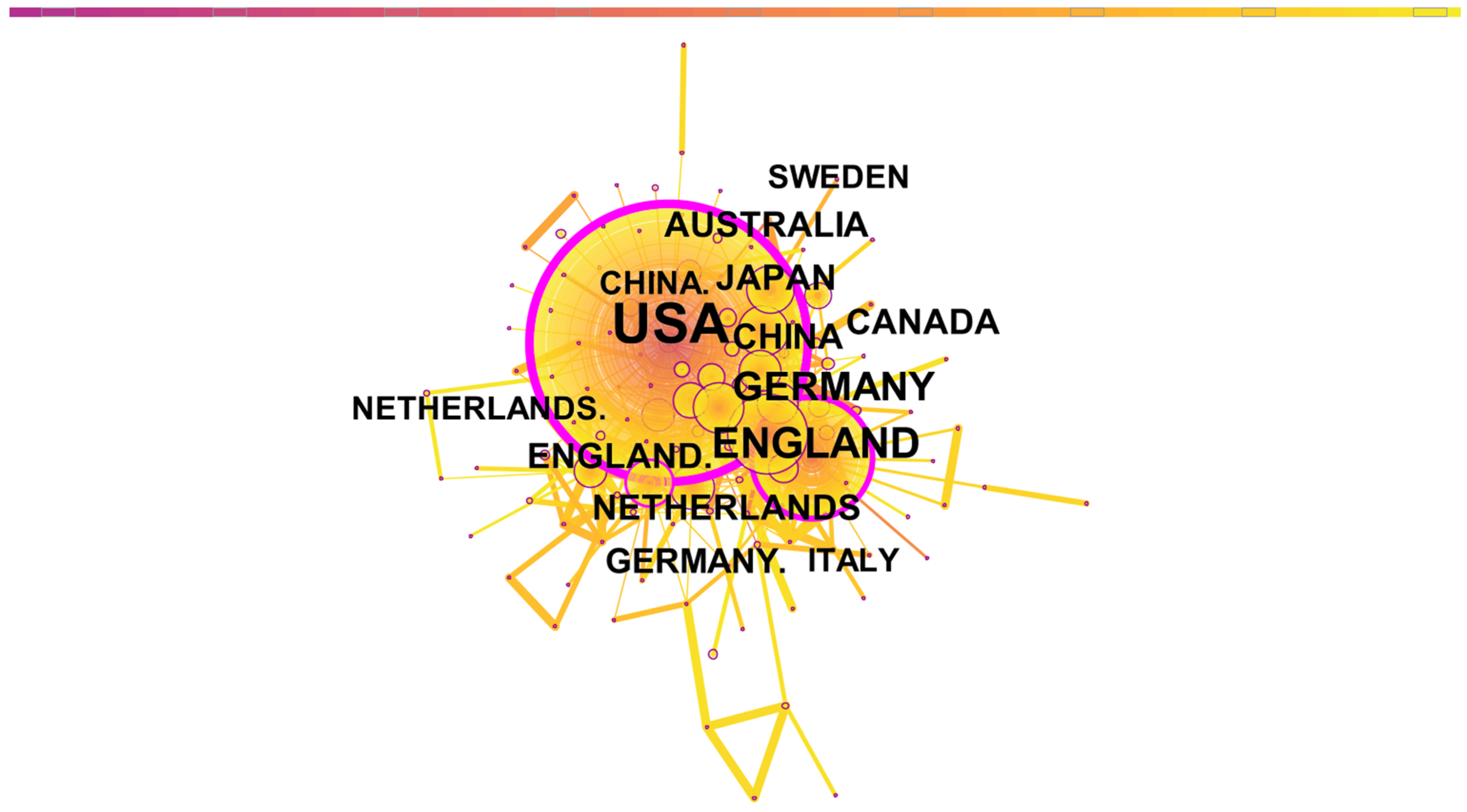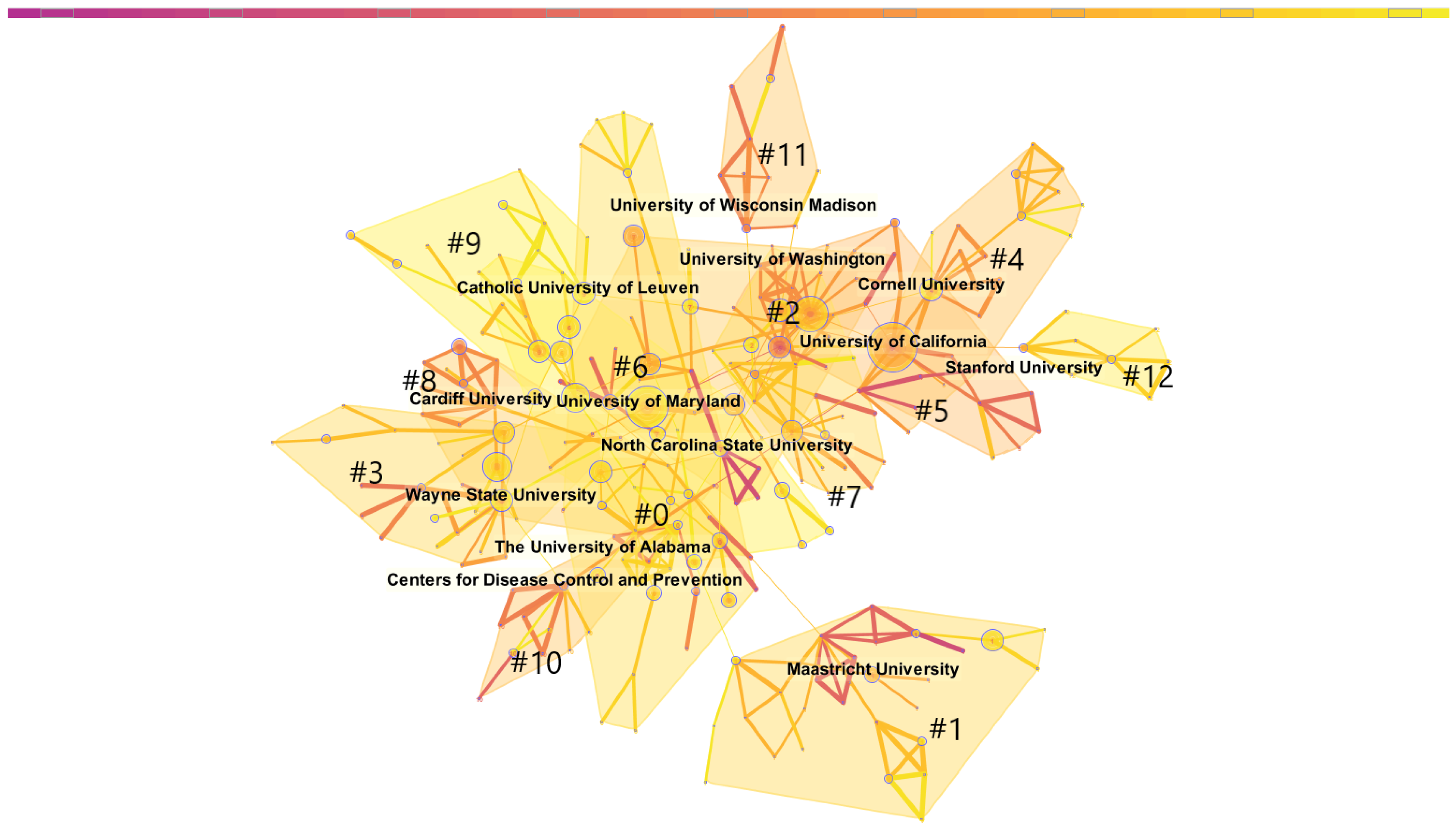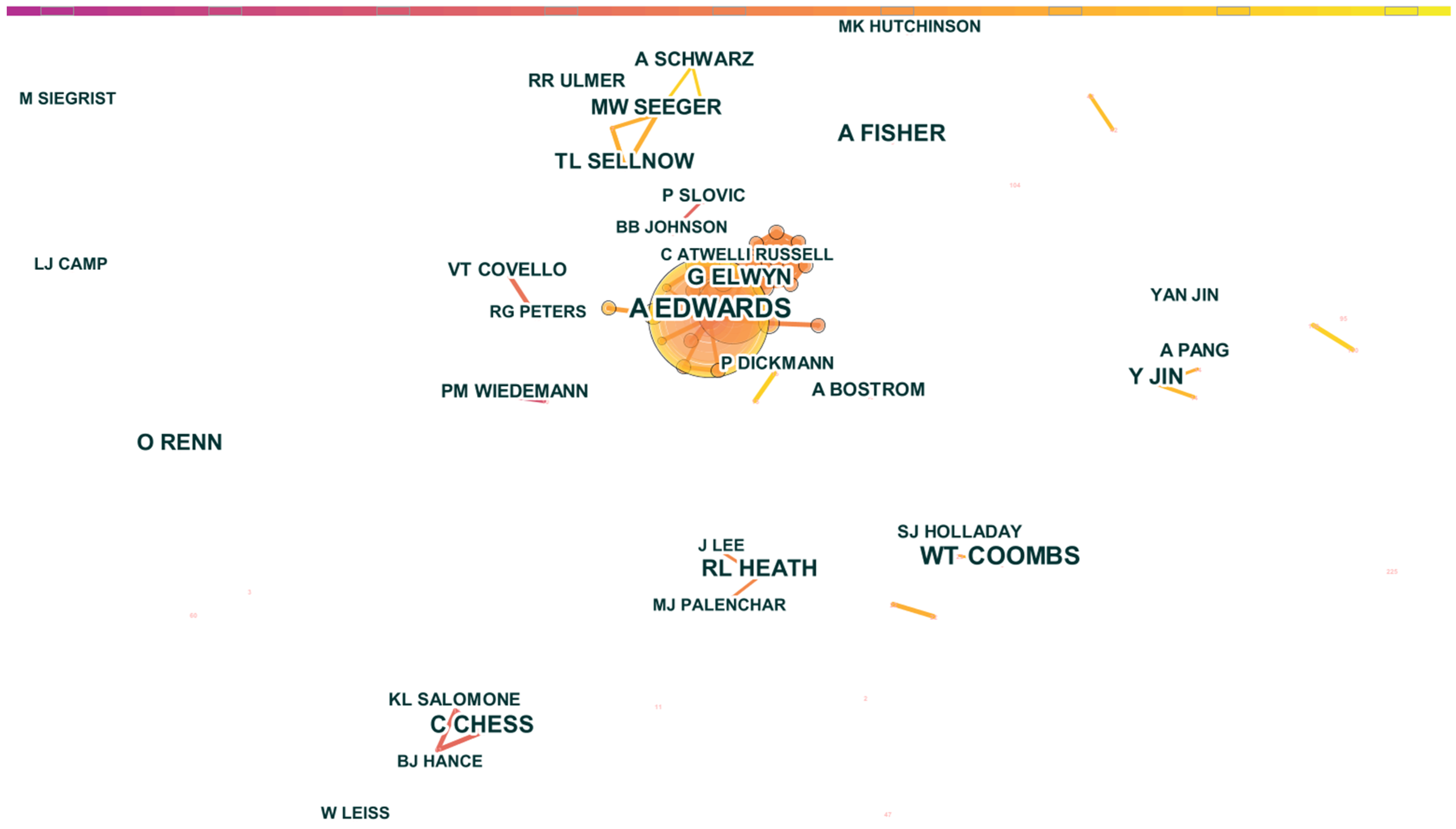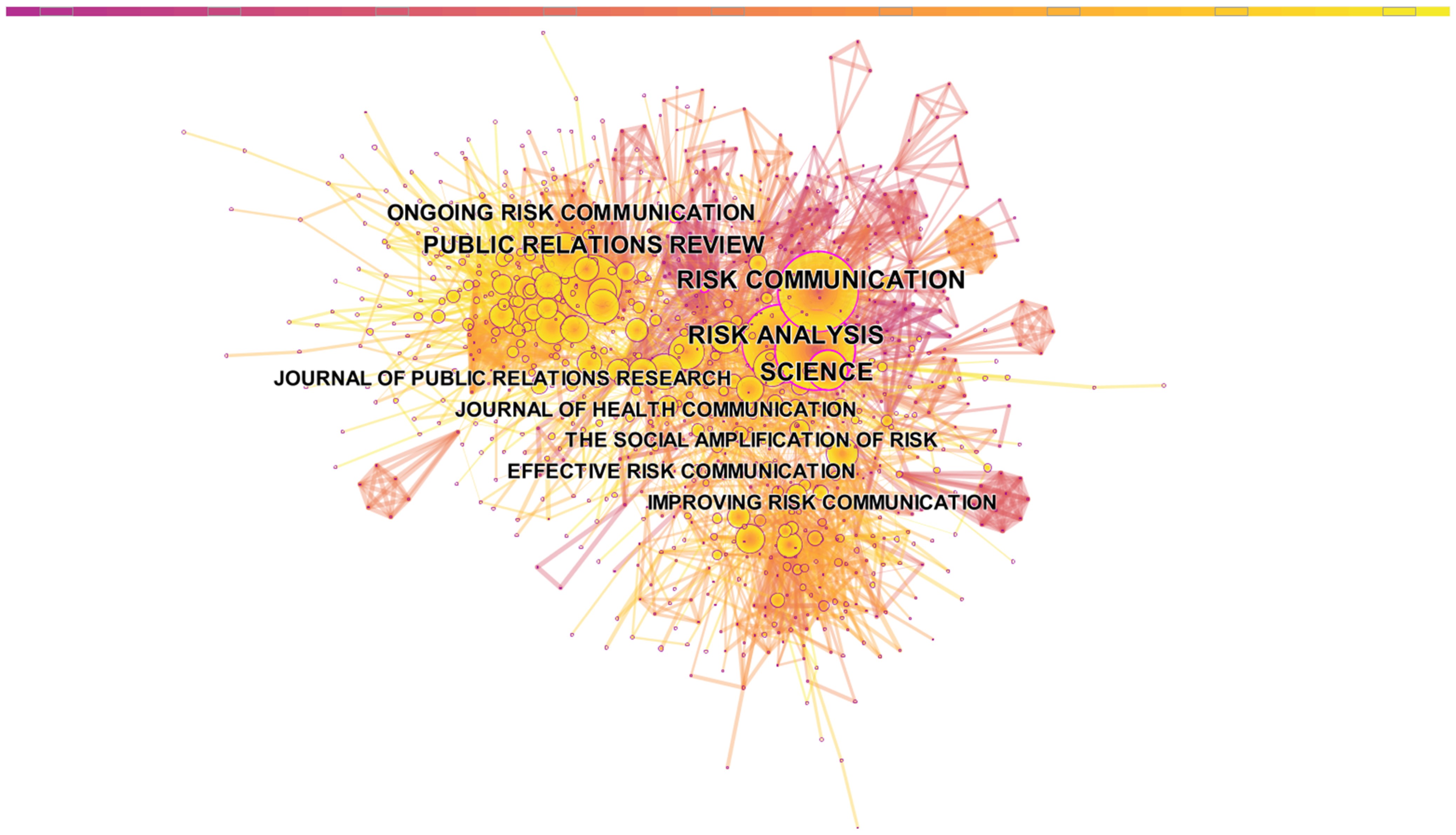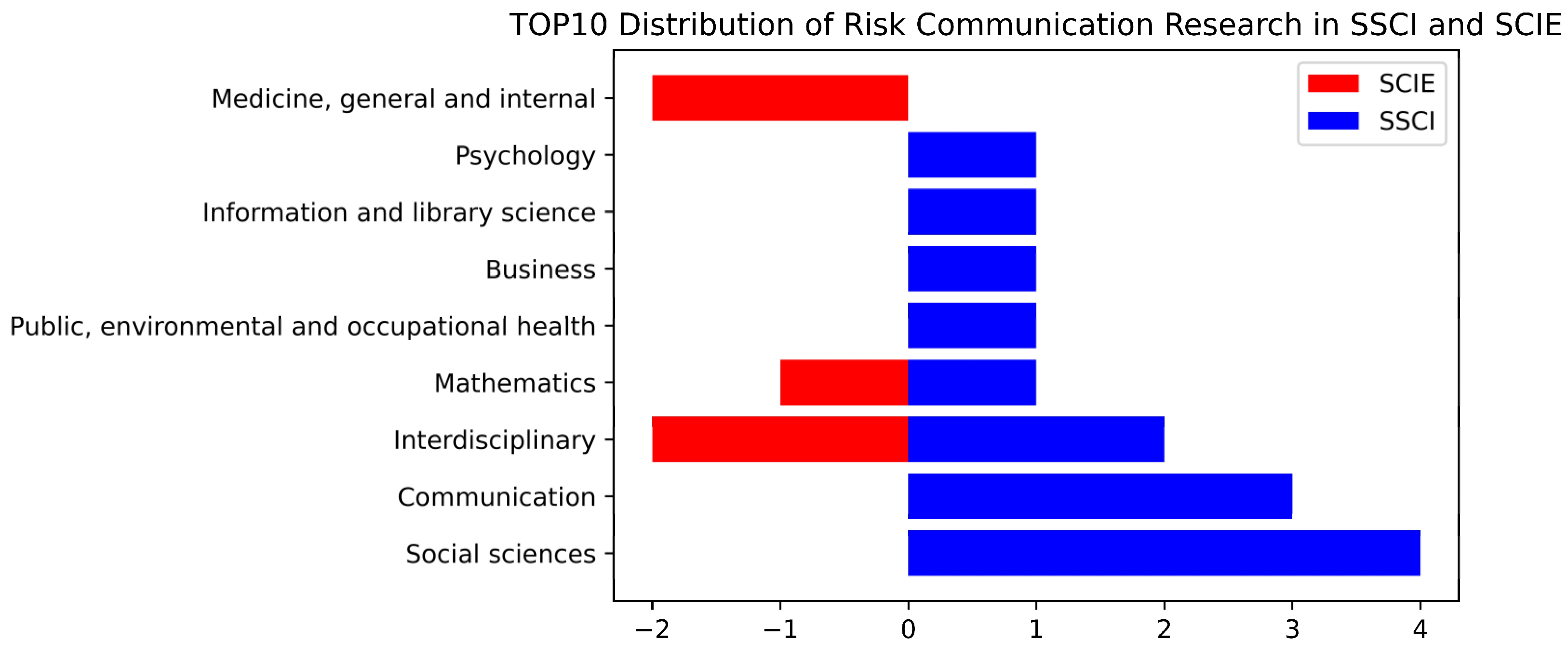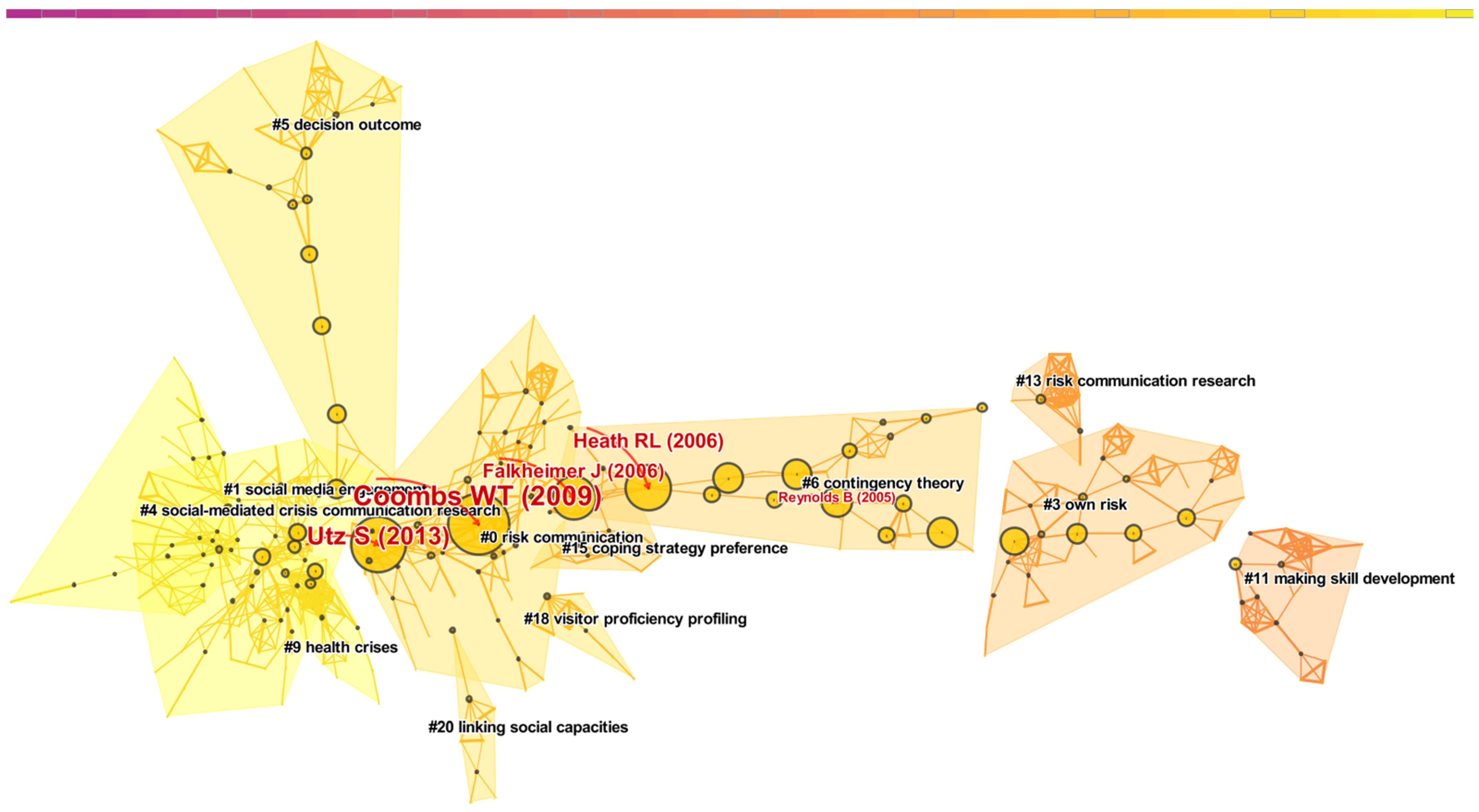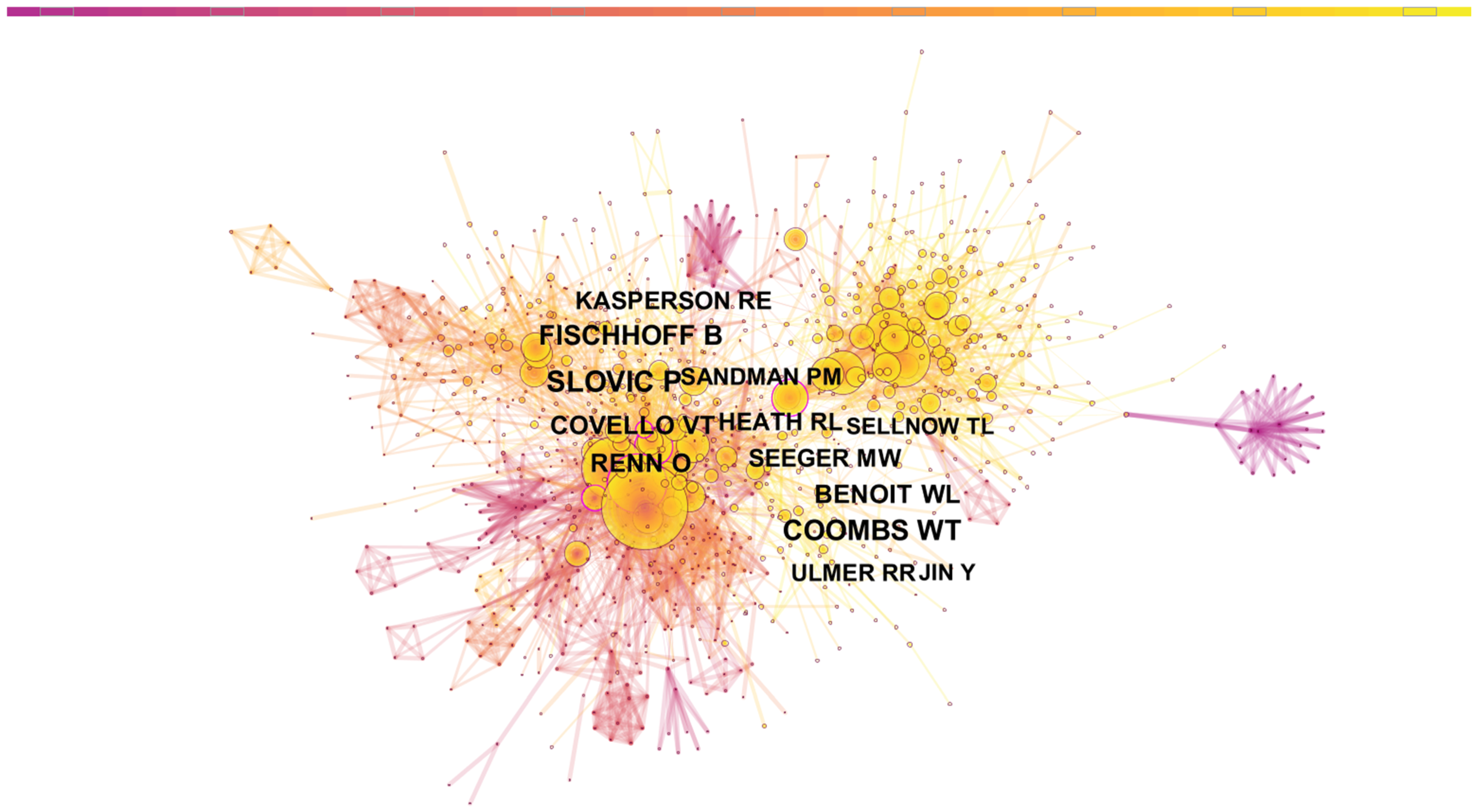1. Introduction
Since the beginning of the COVID-19 outbreak in December 2019, human societies have been facing a crisis caused by variants of the virus, such as Delta and Omicron [
1,
2]. Rapid vaccine development and communication strategies are challenges in the face of major public health emergencies [
3]. The government and the media should use risk communication strategies to warn citizens about a potential epidemic development and flexibly use crisis communication to address the outbreak risks [
4]. The repeated alternation of risks and crises poses great challenges to scholars and practitioners.
Crisis communication and risk communication are essential aspects and approaches of risk management and emergency management, respectively [
5]. However, due to the confusion and overlap in their definitions, their reference and applications have become very complicated [
6]. The fundamental reason is that although the boundary between these two concepts is clear in definition, the operable boundary in practical applications is fuzzy and mutually transformative in nature. For example, (a) when the risk communication fails, the potential threat will be directly transformed into a crisis. In addition, the subsequent communication will also become crisis communication [
7]. Similarly, follow-up risk communication is still needed to prevent a second crisis [
8]. Moreover, even in crisis communication, there are potential risks. (b) Both work to reduce the likelihood or extent of harm. (c) Finally, communication is the primary means of both. Thus, instead of attempting to separate the two concepts, they should be integrated. Therefore, with the emergence of the Crisis and Emergency Risk Communication (CERC) model [
9], academic research on crisis and risk communication has entered a new stage.
Crisis and risk communication research (CRCR) have rapidly developed due to the importance of crisis and risk in many fields: social sciences, medicine, business, environmental science, arts and humanities, engineering, economics, econometrics and finance, computer science, medicine, management and accounting, and so on. However, few studies have systematically investigated CRCR’s comprehensive intellectual landscape.
Publications contain citations and references, which identify the sources used, demonstrate the depth of the research, put work into context, and acknowledge other scholars’ work. While there seems to be a lack of unifying theories on citations in academic works, Merton [
10] argued from a normative perspective that citations are institutional forms to recognize and reward scientists’ work. Cronin [
11] criticized the validity of citations’ use as a proxy for recognition and the quality of the cited work. However, he suggested that they can be utilized to shape a holistic understanding of the scholarly communication system [
12]. From a social constructionism perspective, referencing in papers exposes connections between established theories and observations, resulting in the construction of consilience networks. In this paper, however, we use citations to determine the interconnected channels of scientific information and construct bibliometric networks.
Among the methods employed for the bibliometrics network construction, scientific metrology is one of the most effective to describe a specific academic field comprehensively and quickly [
13]. It involves collecting all of the literature in a particular field within a specified period and constructing a review of the field corresponding to different data elements in the literature. Scientific metrology is a quantitative evaluation method for scientific activities based on bibliometrics and scientific statistics. Its evaluation process has strong objectivity, authority, simplicity, and repeatability. Objectivity means that scientific measurement is not affected by the subjective relationship of the “peer network” linked by the complex relationship between the academic and the social. Authority means that the scientific measurement method is based on Science Citation Index (SCI), Social Sciences Citation Index (SSCI), and other internationally famous literature retrieval tools, with strict screening standards and procedures. Finally, simplicity means that scientific measurement includes many accepted algorithms, and relevant indicators can reflect the “influence” of most papers.
As of 2021, few efforts have been made regarding “crisis communication” or “risk communication.” Among them, the most representative are by Goerlandt et al. [
14], Dong et al. [
15], and Deng [
16]. In terms of risk communication, Goerlandt et al. [
14] analyzed the field of risk communication using CiteSpace and identified geographic and national trends, patterns in scientific categories, and representative journals. Dong et al. [
15] compared China and the United States in regard to CRCR for four dimensions—individuals, institutions, countries, and keywords. In terms of crisis communication, Deng [
16] used CiteSpace to analyze 4116 crisis communication papers published on Web Of Science (WOS) from 2010 to 2020. The author identifies the most influential authors, institutions, theories, papers, hot topics, and future trends in crisis communication research. However, these works are not comprehensive. For example, these three studies used only one database and utilized incomplete search terms (although one search term can describe the field more accurately, the overlap between crisis communication and risk communication in the development process was ignored). Additionally, Goerlandt et al.’s [
14] study focused only on the national level and lacked consideration of the role of individuals and institutions, such as author cooperation analysis, author co-citation analysis, institutional cooperation analysis, and journal co-citation analysis. Similarly, Dong et al. [
15] studied only a small number of items in the comparative analysis and did not report whether the literature data in WOS excluded Chinese data. Deng [
16] was unable to propose a research agenda based on the research results to suggest directions for future research. Moreover, no work has combined risk communication and crisis communication as search terms to explore the development context between the two. Based on previous work, this study proposes the following objectives:
To identify the current state of cooperation at the national, institutional, and individual levels in the CRCR area as well as the most productive countries, institutions, and individuals;
To identify highly regarded journals, literature and authors in the CRCR field;
To discover major research topics in the CRCR field;
To explore the turning points in the evolution of CRCR;
To determine CRCR’s future research agenda.
Therefore, this study expands the scope of the literature by adding additional sources, search terms (risk communication and crisis communication), and time span. This study was conducted as follows:
- (1)
The co-authorship analysis was conducted at three levels: country, institution, and author.
- (2)
The co-citation analysis was conducted at three levels: journal, literature, and author.
- (3)
The literature co-citation analysis was specifically expressed as cluster analysis, high-co-cited literature analysis, burst analysis, and turning points analysis.
This paper is organized as follows. In the first section, we introduce the research background, review the previous research, and propose the purpose of this research. The second section describes the structure of the methodology. The third section presents the results and corresponding discussion. Finally, the fourth, fifth, and sixth sections offer conclusions, suggestions for future research agendas, and limitations, respectively.
2. Methods
The method flow chart, shown in
Figure 1, reports that this study comprises three steps: data collecting, data processing, and data analysis.
2.1. Data Collection
WOS and Scopus are considered to be the largest citation databases available as of 2021, containing information on literature in various disciplines such as medicine, science and engineering, the humanities, and art [
17]. Additionally, Scopus offers a wider variety of information on the literature in the humanities field and a deeper history of publications dating back to the beginning of the 20th century. Therefore, this paper is based on merged citation data from both databases.
Specifically, this study employed the search terms “risk communication” or “crisis communication”. Moreover, to ensure that non-CRCR-centric articles do not appear among the search results, this research set the search scope as “TITLE.” Therefore, the following search queries were used for data retrieval:
Scopus: (TITLE ({risk communication}) OR TITLE ({crisis communication}) AND PUB YEAR > 1978 AND PUB YEAR < 2021.
WOS: “risk communication” (Title) or “crisis communication” (Title), Timespan: 1 January 1986 to 31 December 2020.
Ultimately, 4164 available results were retrieved in total: 2418 papers from Scopus and 1746 papers from WOS.
2.2. Data Analysis Tool
The use of bibliometric maps to represent how different types of objects of study (authors, papers, journals, organizations, etc.) are related to one another is considered a useful way to help its visualization and comprehension. Many software programs are currently used to perform bibliometric mapping: CiteSpace, VOSviewer, CitNetExplorer, SCI2, Sci2Tool, Pajek, and Gephi, among others. However, each software program has its advantages and disadvantages.
As
Figure 2 shows, different software focuses on different areas of analysis [
18,
19]. Although some software such as Pajek and Gephi are more capable in network analysis and network visualization, respectively, CiteSpace overwhelms others in terms of comparative comprehensiveness. It covers most functions required by scientific research, such as turning point, dual-map overlay, and timeline.
CiteSpace is a citation visualization analysis software tool that focuses on analyzing the potential knowledge contained in scientific analysis, and has gradually developed against the background of scientometrics and data visualization. CiteSpace can make maximum use of the information contained in the literature to conduct a structured and timeline analysis of past research in the field, such as using author, institution, and country information to describe authors, institutions, and countries that have made significant contributions to the area over previous decades. CiteSpace can also use title, abstract, and keywords to predict the field’s future development. CiteSpace’s comprehensiveness is its most significant advantage, so we chose this software package as our research tool in this study.
2.3. Data Processing
2.3.1. Data Format Conversion
Due to the difference in variables in the output files from Scopus and WOS, the datasets had to be converted for match and merge. After conversion, both datasets were merged into a single text file. The composition of the combined dataset is shown in
Table 1.
2.3.2. Data Deduplication
We used CiteSpace to remove duplicated data. During this process, 405 duplicate records were deleted; 3271 unique records remained in our revised dataset.
2.3.3. Yearly Outputs
After cleaning and converting the dataset, a quantity chart of CRCR publications per year was acquired, as shown in
Figure 3.
As shown in
Figure 3, we found that the year 2020 (38.08%) had the highest growth rate (over 100 papers), possibly because the COVID-19 outbreak brought more interested researchers into the CRCR field.
2.3.4. Software Parameter Settings
After data processing, we imported the dataset into CiteSpace for exploration and analysis. The specific parameter settings used in CiteSpace were as follows:
Time slicing includes “Time” and “Years Per Slice.” “Time” specifies the year range of publication. The starting point of this study is January 1979, and the ending point is December 2020. “Years Per Slice” divides data time zone in the unit of year, and one year is this study’s set value.
The map made by CiteSpace does not use the original co-occurrence matrix; it uses algorithms to normalize the matrix based on the original matrix and then uses the new matrix for network visualization. These algorithms include the Jaccard index, Cosine similarity measure, Dice coefficient, and Pointwise mutual informationConfiguring CiteSpace to display information about nodes whose frequency exceeds the target frequency.
The term density describes the strength or tightness of connections between nodes in a network and is calculated by dividing the “actual number of relationships” in the network by the “theoretical maximum number of relationships.” The more connections between nodes, the greater the density of the network is, and the greater the network’s density, the greater the influence of the network between nodes is. The values of density range from 0 to 1. When all nodes in the network are connected, the density equals one, and vice versa.
The silhouette value is a measure of network homogeneity. A silhouette value above 0.5 is considered reasonable, and one of 0.7 has a high confidence.
Modularity is the evaluation index of network modularization and is represented by the letter Q. Q value’s range is between 0 and 1. Exceeding 0.3 indicates that the resulting network community structure is significant.
Betweenness centrality is an indicator of a node’s importance based on the number of shortest paths that pass through it. CiteSpace employs this metric to discover and assess the impact of the literature on the network. When the betweenness value of a node exceeds 0.1, CiteSpace uses a purple circle to highlight the node.
2.4. Data Analysis
2.4.1. Co-Authorship Analysis
Co-authorship is an association between two or more researchers who collaborate to report their research findings on a specific topic. This term can be thought of as reflecting social networks encompassing researchers that reflect collaboration among them. It is clear that the primary use of co-authorship networks is to investigate the structure and evolution of scientific collaboration [
20,
21]. Glänzel and Schubert [
22] first explored scientific cooperation at the level of individuals and countries. However, because the intermediary role of institutions was ignored, this approach resulted in a gap in the research on cooperation between individuals and countries. When more boundaries are crossed, the collaboration becomes more productive and diverse [
23], and the co-authorship becomes more likely. In contrast, Chen and Liu’s [
24] analysis of scientific cooperation in high-speed rail research is more comprehensive as it explores productive individuals, institutions, and countries. Based on previous research, our study also included an analysis of the scientific cooperation network in CRCR from micro, meso, and macro perspectives.
The co-authorship analysis consisted of country co-authorship, institution co-authorship, and author co-authorship analyses.
2.4.2. Co-Citation Analysis
When two journals, pieces of literature, or authors appear simultaneously in the references of a paper, they are said to have co-citation relationships [
25]. If the co-citation frequency is high, the academic relationship between the two is close. This study analyzes co-cited journals, co-cited papers, and co-cited authors.
The co-citation analysis consisted of journal co-citation, literature co-citation, and author co-citation analyses. Among these, literature co-citation was examined using cluster analysis, high co-cited literature analysis, burst analysis, and turning points analysis.
5. Conclusions
To understand the evolution of CRCR, we conducted a comprehensive scientometric analysis of the CRCR field using co-author and co-citation analysis. In this study, we used CiteSpace as a research tool and WOS and Scopus papers published from 1978 to 2020 as research objects.
First, the co-authorship analysis conducted in this paper can be divided into three dimensions: country, institution, and individual. At the country level, the US, England, Germany, China, and the Netherlands are the five countries with the highest paper output. The US, England, and the Netherlands have made outstanding contributions to international cooperative research, and the US has a considerable advantage in terms of volume and field of cooperation. At the institutional level, the network centered on the University of Alabama has the highest cooperation intensity, forming a close cooperative relationship. The University of California, the University of Maryland, and Wayne State University are highly productive. At the individual level, a total of nine groups were identified, among which the group with Adrian Edwards as the core and Glyn Elwyn, C Atwell, and Ian Russell as the team members had the highest intensity. In addition, the most productive author was Adrian Edwards from Cardiff University in UK. W. Timothy Coombs from Texas A&M University in the US and Ann Fisher from Pennsylvania State University in the US ranked second and third, respectively.
Second, the co-citation analysis included three dimensions: journal, literature, and individual. At the journal level, Risk Analysis ranked first with 378 citations, and Science and Public Relations Review followed with 302 and 297 citations, respectively. Among the top ten most frequently cited journals, there were ten subcategories of SSCI journals and four subcategories of SCI journals. Humanities and social sciences occupied a dominant position, and the top four disciplines were social science (4), interdisciplinary (4), communication (3), and medicine, general and internal (2).
At the literature level, the cluster analysis showed four main themes in the CRCR field: risk communication (parameters), risk communication (social media), health risk communication, and social-mediated crisis communication research. Different topics contain many different research directions. For example, risk communication (parameters) includes the standardization of crisis communication, the development status of risk communication in different countries, and the coexistence of case studies and theoretical studies. Risk communication (social media) includes measuring the use of social media in crisis management, bibliometrics research of crisis communication, and pre-crisis communication. Health risk communication consists of the ethics of medical decision-making and risk communication. Finally, as the most popular model, social-mediated crisis communication research has become a unique topic.
The high co-cited literature analysis showed that Schultz et al. [
28] were cited with the highest frequency (29 citations). According to the burst analysis calculation, we found that hot spots generated between 2000 and 2020 can be divided into four types: risk communication (medicine), crisis communication (apology and attribution theory), crisis communication (medium), and SMCC. Risk communication in medical aspects attracted great attention from 2003 to 2012. Apology and attribution theories were key research agenda from 2007 to 2013. From 2010 to 2018, studies on crisis communication strategies and channels were highlighted. Finally, research based on SMCC also increased its presence. The turning points analysis showed that the research context of CRCR moved through four stages: case analysis, theoretical framework, channel research, and social media. The US holds nine of the top ten spots at the individual level, with Paul Slovic from the University of Oregon ranked first with 404 total citations.
6. Limitations
First, although the keywords of risk communication and crisis communication selected in this study met the research purpose of this paper, they cannot form complete coverage of health communication. In addition, we did not include databases from other medical fields in this study.
Second, this study explored some correlation between risk communication and crisis communication in the development process; thus, the two search terms were combined. Third, future studies can perform a comparative analysis of risk communication and crisis communication to explore the differences in research fields between the two search terms.
Fourth, this study covered all of the years that included relevant literature, a relatively large time span; thus, it is necessary to carry out a nuanced analysis of the literature data of the past 5 and 10 years so that the results reflect more accurate information.
Finally, most studies, including ours, only examine developed countries. We may always tend to examine the top 10 countries, organizations, and authors, and developed countries are more likely to be in the top 10. Future research should focus on some of the countries we missed in our list.

